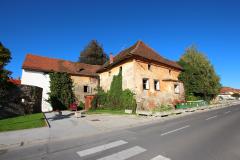
ŽIČKI DVOR (ŽIČE COURT)
Location: Vojašniški trg (Barracks Square) 2b and 2c, Vojašniška ulica 23
Architect: unknown
Time of construction: before 1300-first half of the 15th century (east section), first half of the 15th century-first half of the 17th century (west section of the court), around 1440 (chapel in the west section), 1570-1579 (Renaissance renovation), 1602-1605 (another renovation), 17th century (southern wings and renovation of the eastern and western sections), 18th century (works in the western arm of the southern wing)
Žički dvor (Žiče Court) belonged to the Carthusian monastery Žiče. With this Freihaus, the monastery established a solid economic and civic centre for their trading business, as well as for their properties and income in Maribor and its vicinity. The monasteries' courts offered the chance for a temporary stay, as well as the storage of wine, grain and other produce. Because of the latter, the courts also functioned as trading posts. Archival sources do not reveal in which year the monastery became the owner of Žički dvor or when it commissioned its construction.
Even though the court, which lies on the left riverbank of the Drava River, east of the Minorite monastery, is first mentioned in sources in 1306, the Carthusian monks owned the court and its corresponding land even before 1300. They obtained their first property close to the town as early as the 12th century, and even before 1306, they were exempt from paying a financial contribution for the maintenance of the town wall. However, they had to take care of the wall that surrounded their court. They also had numerous privileges at that time: they were exempt from paying taxes for Žički dvor, as well as from paying octrois for wine and other homemade produce stored in the court and its basement. Furthermore, the monks were allowed a retail sale of wine at the court without paying tax, while a subject of the court could sell half of their wine load per year at the court. The monks and nuns living in the court also obtained the privilege of being exempt from paying taxes and tributes. On the contrary, all other residents of the court would have to fulfil the same obligations as other townspeople. In the 15th century, the monks acquired the land on the northern side of the court on agreement that neither the monks nor the townsmen would develop it. This land provided free access to the building. Because of their monastic rules, the Carthusian monks were not allowed to live in the town court. Consequently, Žiče's property in Maribor and the vicinity was managed by laymen. Starting in the 15th century, Žiče's priors leased out the court with all its land and income numerous times, or the administrators of the monastery lived there with their families. In 1564, the Carthusian monastery of Žiče passed into the hands of Cardinal Caharija Delphin and his administrators as a commandery. Otolin Scazuolo, who collected 200 florins of rent from Maribor's court and also renovated it, administered the building between 1570 and 1579. In 1573, it was rented to the Orčići brothers, who were obliged to let some of the rooms be used by the people of Žiče in the event of a Turkish invasion or other war dangers. Between 1589 and 1591, the administrator of the Carthusian monastery was Jurij Freyseisen, the abbot of the monastery in Rein. At that time, the court and its corresponding land were in bad condition. Between 1602 and 1603, leaseholder Tomaž Reichel, in agreement with the prior Viano Gravelli (1596-1623), made several thorough repairs on the building and improved the state of the court's land. In the time of Žiče's prior Janez Krstnik Schiller (1684-1698), craft works were carried out in the court. Two inventories from 1696 and 1699 are preserved; among other things, they mention the chapel with the altar of St. Anthony of Padua and all the furnishings, numerous framed images and copperplate engravings. Beside the chapel there were six other rooms in the building, as well as a hall, a prelate's room, a kitchen, a pantry, as well as the horses' stable and a coach house in the outbuilding. In 1778, four years before the monastery was dissolved, the court passed into the hands of Joseph Nagerl von Rosenbichl. The Imperial and Royal Treasury bought it in 1786; they arranged a military dressing room in it, in 1810 a military post, and in 1835, a garrison law court with prisons for officers and soldiers. From 1928 it was used for apartments.
In medieval times, the court encompassed the eastern wing, which leaned on the town wall, and a somewhat younger western wing with the Chapel of All Saints that stood outside of the town wall. The court was renovated in the Renaissance, while its current size and shape stem from the 17th century, when its southern half, comprised of two arms, an interim wing and the defence courtyard wall, was built outside of the wall.
The irregular design of the court's ground plan and storey is a result of the graduated terrain, which descends from the north to the south and from the east to the west, as well as a result of numerous construction works from medieval times to the 20th century. The eastern part, which was built in two construction phases, represents the centre of the court. It has a pass-through vestibule and four rooms with a Baroque staircase on the ground floor, and three rooms and a kitchen on the first floor. Even though today's flooring, room arrangement, doors, windows and the staircase are from the end of the 17th century, the foundation of the eastern part dates back to medieval times. The construction of the western part, which was carried out in stages, followed between the first half of the 15th and the first half of the 17th centuries. The current flooring, the arrangement of the rooms and wall openings, and the staircase were made in Baroque. Before that the floor was higher and it had a groined vault; part of this vault is preserved above the current one and reaches to the attic. After the Baroque renovations there were three large rooms and a staircase in this part of court. The rooms on the ground floor had a barrel vault, while the ones on the first floor had a flat ceiling. A unified concavely profiled Baroque cornice can be found on the exterior.
As early as in medieval times, part of the western wing was used as a chapel. Its altar of All Saints was consecrated in 1440. The chapel with a basement, with which the court expanded over the town wall, was built in the southern extension of the then western court façade. It stretched over one storey and a half. A slightly pent-in barrel vault with three pairs of shallow spandrels and the auricular profiled square stone frame of a round window are the result of Renaissance reconstructions after 1570.
In the 17th century, the court was again expanded over the town wall. At that time, the arms with an interim narrow wing and a defensive wall, which closed off the new inner courtyard towards the south, were constructed. The corners of the east wing, which dates back to the first half of the 17th century, expand in the shape of a trapezius in the lower part; the windows on the ground floor have simple stone frames. The walled up semi-circular arch, which provided the access to the gable vaulted room on the ground floor, can be seen on the courtyard side. In the broader western wing three construction phases can be distinguished: from the first half of the 17th century, from the second half of the 17th century, and from 1764 to 1765. In the youngest, i.e. the eastern bay, there are two residential storeys, while in the other three, there are three storeys. These are the basement, the residential floor and the attic. Three windows on the southern and one on the western façade have profiled stone frames with curtain rods from the second half of the 17th century. The storeyed corridor in the courtyard with a connecting staircase between both wings was built before 1670. Two connecting staircases, as well as barrel, groined and cap vaults in the basement and on the ground floor were also made when this wing was built. At that time, the chapel and the area in front of it were decorated with two profiled portals and lintels. The backfilled courtyard, which was closed off with a strong wall with numerous buttresses and slits, was built at the same time as the interim wing. The nucleus of the ground floor outbuilding, which separates the court from Vojašniški trg (Barracks Square), is from the 17th century, while reconstruction works followed in the 18th and 19th centuries.
In the 17th century, Žički dvor, which at first stood beside the northern interior side of the town wall, and later also beside the exterior southern side, obtained its form, size and function of a wall fort providing protection for the town harbour. Consequently, the town wall was transferred to the court's both southern wings and to the interim wing with its courtyard wall equipped with slits. When Benetke (Venice) was removed in 1967, the court became the most picturesque structure in the appearance of this part of town.
Mija Oter Gorenčič
(23 September 2014)







